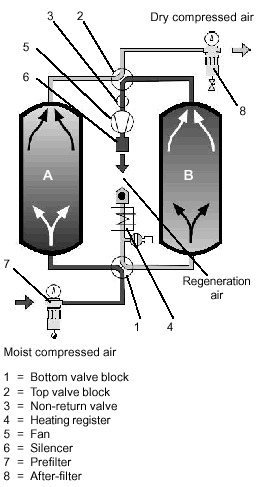<BR> Fig. 5.18:
Op. diagram of an adsorption dryer,
Vacuum regeneration
Fig. 5.18:
Op. diagram of an adsorption dryer,
Vacuum regeneration | 1st Phase
A vacuum pump draws in air from the outside. This flow of air is heated by a heating register and drawn through the drying tank. Once the regeneration temperature is reached, the water releases itself from the Adsorption material. The flow of regeneration air takes on the moisture and transports it into the open through an outlet valve.
2nd Phase
In a cooling phase the operating temperature drops back to the temperature of the drying tank. For this purpose the heating register is switched off and cold air from the atmosphere is directed through the drying tank.
Features
- Economical with high volume flows
- No additional compressed air consumption.
No compressed air is taken from the system for regeneration.
- Long utility time of drying agent.
Thermal stress on the drying agent is low.
- Energy savings through lower regeneration temperature.
- Prefiltration of inlet air.
A pre-filter removes most of the oil, water droplets and dirt particles from the compressed air.
- Postfiltration of dried compressed air.
Drying materials taken with the compressed air from the drying tank must be filtered out of the compressed air.
|